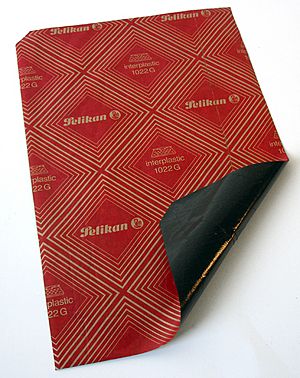Carbon paper facts for kids
Carbon paper is a special type of paper that helps you make copies of what you write or type. One side of the paper is covered with a dry ink, which is usually mixed with a type of wax. You place carbon paper between two regular sheets of paper. When you press down on the top sheet (like when you write with a pen or type on a typewriter), some of the ink from the carbon paper transfers to the second sheet. The copy created this way is called a carbon copy. Because this method relies on pressure, you can usually only make about four or five clear copies at once.
Contents
What is Carbon Paper?
Carbon paper is a simple but clever invention. It's a thin sheet of paper or film that has a special coating on one side. This coating is made of a dry, waxy ink. When you use it, the carbon paper acts like a middleman, transferring your writing or typing from one page to another. It was a very common tool before modern photocopiers and computer printers became widely available.
How Does Carbon Paper Work?
Imagine you have three sheets of paper: your original document on top, the carbon paper in the middle (with its inky side facing down), and the paper you want to copy onto at the bottom. When you write or type on the top sheet, the pressure from your pen or typewriter key pushes down. This pressure makes the dry ink on the carbon paper release tiny bits of color onto the sheet below it. It's like a stamp, but instead of a rubber stamp, the pressure from your writing creates the image.
Why Was Carbon Paper Used?
For many years, carbon paper was the main way to make instant copies of documents. Before photocopying machines were common, if you needed multiple copies of a letter, invoice, or receipt, carbon paper was the go-to solution. It was especially useful for businesses, offices, and anyone who needed to keep records or send identical copies to different people. It allowed for quick, on-the-spot duplication without needing any electricity or complex machines.
The History of Carbon Paper
The idea of carbon paper has been around for a long time. The first known patent for "paper for manifold writing" was given to an Englishman named Ralph Wedgwood in 1806. He created it to help blind people write, as it made a raised mark they could feel. Later, in 19th-century Italy, Pellegrino Turri also invented a type of carbon paper for his blind friend, Countess Carolina Fantoni da Fivizzano, so she could write letters. As typewriters became popular in the late 1800s, carbon paper became even more important. It was a key part of office work for over a century until new technologies like photocopiers and computers took over.
See also
- Copying (documentary)
- Typewriter
- Office equipment
 In Spanish: Papel carbón para niños
In Spanish: Papel carbón para niños


